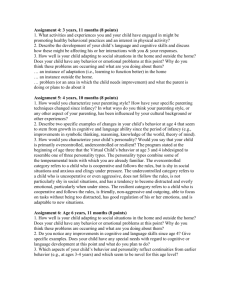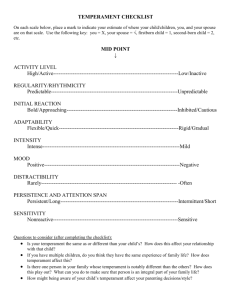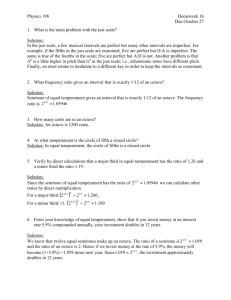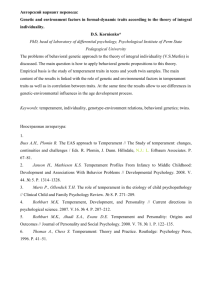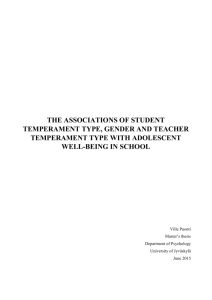The Effect of Temperament on Classroom Behavior and School
advertisement
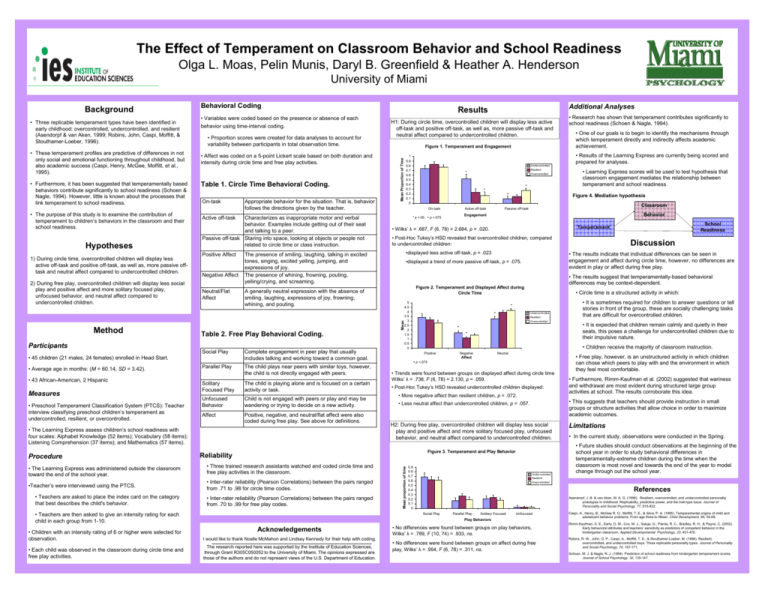
The Effect of Temperament on Classroom Behavior and School Readiness Olga L. Moas, Pelin Munis, Daryl B. Greenfield & Heather A. Henderson University of Miami • Furthermore, it has been suggested that temperamentally based behaviors contribute significantly to school readiness (Schoen & Nagle, 1994). However, little is known about the processes that link temperament to school readiness. • The purpose of this study is to examine the contribution of temperament to children’s behaviors in the classroom and their school readiness. Hypotheses 1) During circle time, overcontrolled children will display less active off-task and positive off-task, as well as, more passive offtask and neutral affect compared to undercontrolled children. 2) During free play, overcontrolled children will display less social play and positive affect and more solitary focused play, unfocused behavior, and neutral affect compared to undercontrolled children. Method Participants • Proportion scores were created for data analyses to account for variability between participants in total observation time. • Affect was coded on a 5-point Lickert scale based on both duration and intensity during circle time and free play activities. Table 1. Circle Time Behavioral Coding. On-task Characterizes as inappropriate motor and verbal behavior. Examples include getting out of their seat and talking to a peer. Passive off-task Staring into space, looking at objects or people not related to circle time or class instruction. • 43 African-American, 2 Hispanic Measures • Preschool Temperament Classification System (PTCS): Teacher interview classifying preschool children’s temperament as undercontrolled, resilient, or overcontrolled. Positive Affect Negative Affect Neutral/Flat Affect A generally neutral expression with the absence of smiling, laughing, expressions of joy, frowning, whining, and pouting. Table 2. Free Play Behavioral Coding. Social Play Complete engagement in peer play that usually includes talking and working toward a common goal. Parallel Play The child plays near peers with similar toys, however, the child is not directly engaged with peers. Solitary Focused Play The child is playing alone and is focused on a certain activity or task. Unfocused Behavior Child is not engaged with peers or play and may be wandering or trying to decide on a new activity. Affect Positive, negative, and neutral/flat affect were also coded during free play. See above for definitions. Overcontrolled y * On-task y Active off-task •Teacher’s were interviewed using the PTCS. • Inter-rater reliability (Pearson Correlations) between the pairs ranged from .71 to .98 for circle time codes. • Inter-rater reliability (Pearson Correlations) between the pairs ranged from .70 to .99 for free play codes. • Teachers are then asked to give an intensity rating for each child in each group from 1-10. I would like to thank Noelle McMahon and Lindsey Kennedy for their help with coding. • Each child was observed in the classroom during circle time and free play activities. The research reported here was supported by the Institute of Education Sciences, through Grant R305C050052 to the University of Miami. The opinions expressed are those of the authors and do not represent views of the U.S. Department of Education. • Learning Express scores will be used to test hypothesis that classroom engagement mediates the relationship between temperament and school readiness. Classroom Passive off-task Behavior •displayed less active off-task, p = .023 • The results suggest that temperamentally-based behavioral differences may be context-dependent. Figure 2. Temperament and Displayed Affect during Circle Time • Circle time is a structured activity in which: y y Discussion • The results indicate that individual differences can be seen in engagement and affect during circle time, however, no differences are evident in play or affect during free play. •displayed a trend of more passive off-task, p = .075. 5 4.5 4 3.5 3 2.5 2 1.5 1 0.5 0 School Readiness Temperament Undercontrolled Resilient Overcontrolled y y • It is sometimes required for children to answer questions or tell stories in front of the group, these are socially challenging tasks that are difficult for overcontrolled children. • It is expected that children remain calmly and quietly in their seats, this poses a challenge for undercontrolled children due to their impulsive nature. • Children receive the majority of classroom instruction. Positive Negative Neutral Affect y p <.075 • Trends were found between groups on displayed affect during circle time Wilks’ λ = .738, F (6, 78) = 2.130, p = .059. • Post-Hoc Tukey’s HSD revealed undercontrolled children displayed: • More negative affect than resilient children, p = .072. H2: During free play, overcontrolled children will display less social play and positive affect and more solitary focused play, unfocused behavior, and neutral affect compared to undercontrolled children. 0.9 0.8 0.7 0.6 0.5 0.4 0.3 0.2 0.1 0 • Free play, however, is an unstructured activity in which children can chose which peers to play with and the environment in which they feel most comfortable. • Furthermore, Rimm-Kaufman et al. (2002) suggested that wariness and withdrawal are most evident during structured large group activities at school. The results corroborate this idea. • This suggests that teachers should provide instruction in small groups or structure activities that allow choice in order to maximize academic outcomes. • Less neutral affect than undercontrolled children, p = .057. Undercontrolled Resilient Limitations • In the current study, observations were conducted in the Spring. • Future studies should conduct observations at the beginning of the school year in order to study behavioral differences in temperamentally-extreme children during the time when the classroom is most novel and towards the end of the year to model change through out the school year. Overcontrolled References Asendorpf, J. B. & van Aken, M. A. G. (1999). Resilient, overcontrolled, and undercontrolled personality prototypes in childhood: Replicability, predictive power, and the trait-type issue. Journal of Personality and Social Psychology, 77, 815-832. Parallel Play Solitary Focused Unfocused Play Behaviors Acknowledgements • Results of the Learning Express are currently being scored and prepared for analyses. • Post-Hoc Tukey’s HSD revealed that overcontrolled children, compared to undercontrolled children: Social Play • Children with an intensity rating of 6 or higher were selected for observation. • One of our goals is to begin to identify the mechanisms through which temperament directly and indirectly affects academic achievement. Engagement • Wilks’ λ = .687, F (6, 78) = 2.684, p = .020. Reliability • Three trained research assistants watched and coded circle time and free play activities in the classroom. • Research has shown that temperament contributes significantly to school readiness (Schoen & Nagle, 1994). Figure 4. Mediation hypothesis Figure 3. Temperament and Play Behavior • The Learning Express was administered outside the classroom toward the end of the school year. • Teachers are asked to place the index card on the category that best describes the child's behavior. Undercontrolled Resilient * * p <.05, y p <.075 The presence of smiling, laughing, talking in excited tones, singing, excited yelling, jumping, and expressions of joy. The presence of whining, frowning, pouting, yelling/crying, and screaming. • The Learning Express assess children’s school readiness with four scales: Alphabet Knowledge (52 items); Vocabulary (58 items); Listening Comprehension (37 items); and Mathematics (57 items). Procedure Figure 1. Temperament and Engagement 1 0.9 0.8 0.7 0.6 0.5 0.4 0.3 0.2 0.1 0 Active off-task • 45 children (21 males, 24 females) enrolled in Head Start. • Average age in months: (M = 60.14, SD = 3.42). Appropriate behavior for the situation. That is, behavior follows the directions given by the teacher. Additional Analyses Results H1: During circle time, overcontrolled children will display less active off-task and positive off-task, as well as, more passive off-task and neutral affect compared to undercontrolled children. Mean Proportion of Time • These temperament profiles are predictive of differences in not only social and emotional functioning throughout childhood, but also academic success (Caspi, Henry, McGee, Moffitt, et al., 1995). • Variables were coded based on the presence or absence of each behavior using time-interval coding. Mean • Three replicable temperament types have been identified in early childhood: overcontrolled, undercontrolled, and resilient (Asendorpf & van Aken, 1999; Robins, John, Caspi, Moffitt, & Stouthamer-Loeber, 1996). Behavioral Coding Mean proportion of time Background • No differences were found between groups on play behaviors, Wilks’ λ = .789, F (10, 74) = .933, ns. • No differences were found between groups on affect during free play, Wilks’ λ = .954, F (6, 78) = .311, ns. Caspi, A., Henry, B., McGee R. O., Moffitt, T. E., & Silva, P. A. (1995). Temperamental origins of child and adolescent behavior problems: From age three to fifteen. Child Development, 66, 55-68. Rimm-Kaufman, S. E., Early, D. M., Cox, M. J., Saluja, G., Pianta, R. C., Bradley, R. H., & Payne, C. (2002). Early behavioral attributes and teachers’ sensitivity as predictors of competent behavior in the kindergarten classroom. Applied Developmental Psychology, 23, 451-470. Robins, R. W., John, O. P., Caspi, A., Moffitt, T. E., & Stouthamer-Loeber, M. (1996). Resilient, overcontrolled, and undercontrolled boys: Three replicable personality types. Journal of Personality and Social Psychology, 70, 157-171. Schoen, M. J. & Nagle, R. J. (1994). Prediction of school readiness from kindergarten temperament scores. Journal of School Psychology, 32, 135-147.
